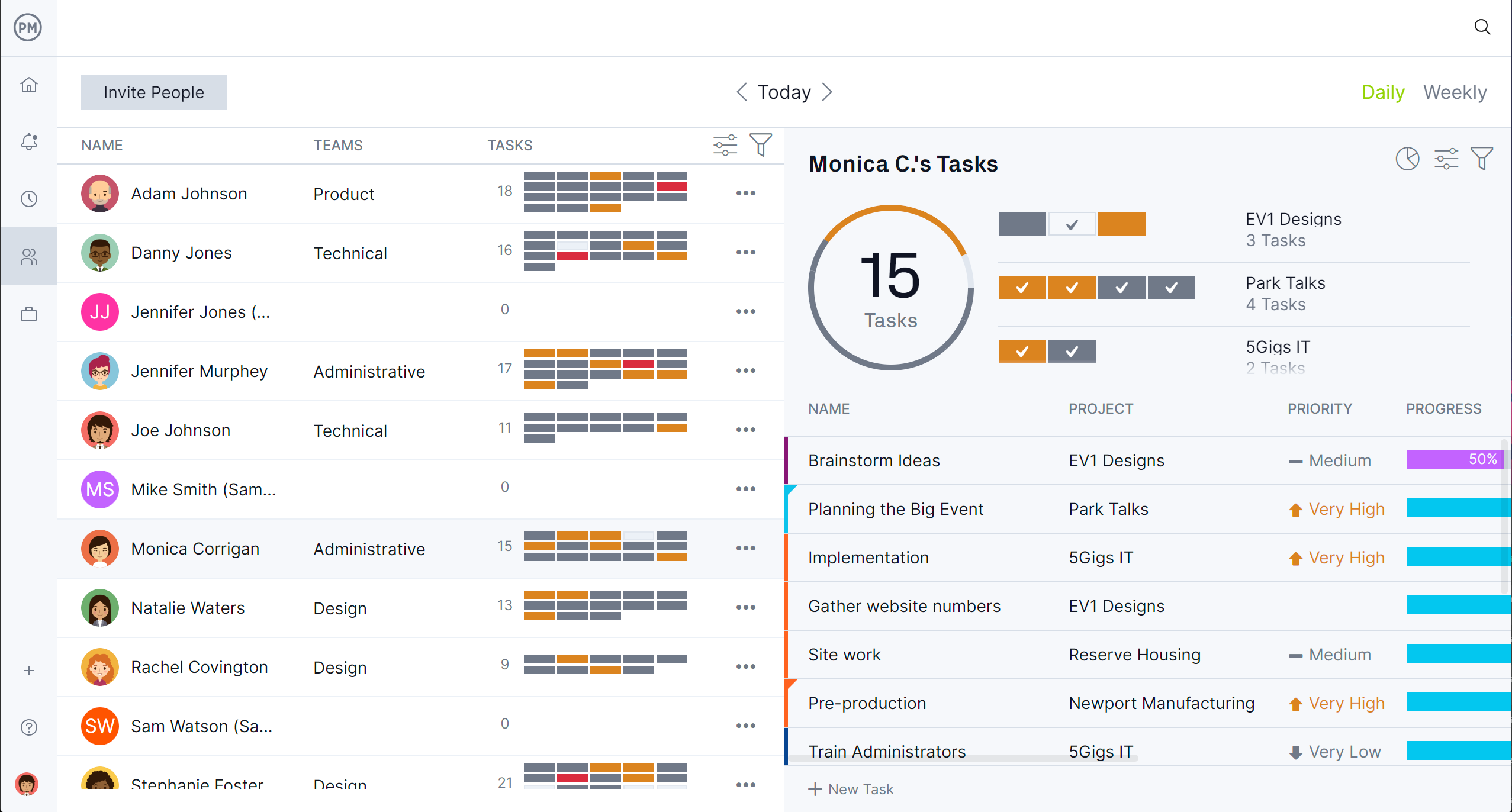Successful projects aren’t had by holding one’s nose and jumping in. There must be preparation. In project management, once a project has been approved, it starts with a project outline.
While a project outline might seem obvious, it’s worth spending a little time defining what the phase means. Once that’s clear, we’ll show when a project outline is made, what should be included and provide an example to show how it works in a real-life scenario.
What Is a Project Outline?
A project outline is a high-level overview that summarizes the key components of a project. It typically includes the project’s objectives, scope, timeline, key milestones, deliverables, stakeholders and resources. A project outline serves as a roadmap, providing an understanding of what needs to be accomplished and how the work will be structured, helping to ensure alignment and effective project management.
True, a project outline isn’t a formal, standardized term that one would find in project management frameworks, such as the Project Management Institute (PMI) and its Project Management Body of Knowledge (PMBOK), PRINCE2 (PRojects IN Controlled Environments) or agile. However, it’s still a widely used concept across industries and project types. The idea can be found in the project brief (PRINCE2), project charts (PMBOK), statement of work and project initiation document.
A project outline also serves as the foundation for creating a Gantt chart by providing the essential details needed to map out tasks and timelines. It identifies key tasks, milestones and deliverables. Additionally, identifying dependencies, resources and responsible team members from the project outline helps accurately sequence tasks and assign responsibilities in the Gantt chart. This is all facilitated by the use of project management software.
ProjectManager is award-winning project and portfolio management software with multiple project views to turn a project outline into an actionable plan. Tasks, resources and costs can be scheduled on the Gantt chart, which goes further by linking all four types of task dependencies to avoid cost overruns.
Improve Project Outlines with ProjectManager
- Use the sheet, list, kanban and calendar view alongside the Gantt to execute outlines
- Reference real-time reports and dashboards to see how outlines are being executed
- Share data with stakeholders using free guest licenses. Try it free


When to Make a Project Outline
A project outline is typically created in the early stages of project planning, often before or alongside the development of a project charter or project proposal. It acts as a simplified version of those documents, helping to break down the project’s key components and organize initial thoughts. Creating a project outline can clarify objectives, identify major tasks and estimate timelines, making it easier to draft a more detailed and comprehensive charter or proposal.
It’s useful for stakeholder discussions, ensuring alignment before committing to more detailed planning. Essentially, a project outline is a practical starting point that streamlines the development of formal project documents by providing a clear, high-level structure.
A project outline is particularly useful when you’re still in the brainstorming or early planning phases. It allows you to explore the project’s feasibility, refine the objectives and identify potential challenges without the commitment of a formal document. If you’re working on a project proposal to gain stakeholder approval or secure funding, the outline summarizes the key points, ensuring you’re aligned on the project’s purpose and scope before investing time in detailed planning. Similarly, when preparing a project charter, which formally authorizes the project and defines roles and responsibilities, the outline serves as a precursor by organizing the core details in a clear, manageable format.
What Should Be Included in a Project Outline?
A project outline serves as a high-level summary that provides clarity and direction for project stakeholders. It helps establish a shared understanding of the project’s purpose, scope and key details. Below are the essential sections that should be included in a project outline.
Project Background
The project background provides context for why the project is being initiated. It typically includes information about the problem or opportunity the project is addressing, relevant industry or organizational challenges and any previous efforts to resolve the issue. This section helps stakeholders understand the motivation behind the project.
Project Overview
This section offers a concise summary of the project, including its name, purpose and a brief description of what will be accomplished. It should cover the key aspects of the project in a few sentences to provide a clear understanding of the project’s intent.
Project Goals and Objectives
Clearly state the goals and objectives the project aims to achieve. Goals are broad statements that define the desired outcomes, while objectives are specific, measurable actions that contribute to those goals. This section provides a benchmark for measuring the project’s success.
Project Scope
The project scope defines the boundaries of the project, outlining what is included and excluded. It specifies the deliverables, features, functions and activities involved. Establishing a clear scope prevents scope creep and ensures all stakeholders are aligned.
Project Management Team
Identify the key individuals and their roles within the project. This typically includes the project manager, team members, sponsors and other stakeholders. Describing the responsibilities of each role ensures accountability and clarity within the team.
Resource Requirements
List the resources necessary to complete the project, including personnel, materials, equipment, technology and facilities. This section helps in planning resource allocation and estimating the overall project needs.
Project Estimated Costs
Provide an initial estimate of the project’s budget. This should include direct and indirect costs such as labor, materials, software and any external services. While the estimate may not be precise at this stage, it should offer a realistic view of the anticipated expenses.
Estimated Project Timeline
Outline the project’s expected timeline, including key milestones, deliverable dates and deadlines. While a detailed schedule may come later, providing an estimated timeline helps stakeholders understand the project’s duration and major phases.
Risks and Assumptions
Identify any potential risks that could impact the project, along with assumptions made during planning. Risks may include technical challenges, resource limitations or external dependencies. Understanding these factors early allows for proactive risk management and contingency planning.
Including these components in your project outline will provide a solid foundation for further planning and ensure that all stakeholders have a clear, consistent understanding of the project from the outset.
Project Outline Example
Now that we understand what a project outline is and the components that make up one, let’s illustrate the process by imagining how one is applied in a real-life scenario. Below is a project outline for the design and construction of a new warehouse.
Project Background
The rapid growth of the client’s e-commerce operations has outpaced the capacity of their current distribution infrastructure. To meet rising demand and reduce shipping times, a new regional warehouse is required.
Project Overview
This project involves the design and construction of a 100,000 sq. ft. warehouse facility in the Greater Dallas area. The warehouse will include receiving and shipping docks, climate-controlled storage, office space and parking for delivery vehicles.
Project Goals and Objectives
Here’s a list of the project’s goals and objectives.
- Expand storage and distribution capacity by Q2 2026
- Improve delivery efficiency in the southern U.S. region
- Construct a cost-effective and scalable facility
- Ensure compliance with local zoning and building regulations
Project Scope
Below is what will be in and out of scope for the project.
- In Scope: Site preparation, permitting, foundation, structural framing, HVAC, plumbing, electrical, interior build-out and final inspection
- Out of Scope: Staffing operations and ongoing warehouse management
Project Management Team
Another step towards realizing the project is determining the team that will lead and execute it. For this project, the project team includes the following.
- Project Sponsor: VP of Logistics
- Project Manager: Construction PM from General Contractor
- Architect: XYZ Design Studio
- Contractor: ABC Commercial Builders
- Civil Engineer, Structural Engineer and MEP Specialists
Resource Requirements
Resources are the people, materials, equipment, etc., needed to execute the project tasks. Those resources are included below.
- Construction materials (steel, concrete, insulation)
- Labor crews for all phases of construction
- Heavy equipment and machinery
- IT infrastructure for security and operations
- Legal and permitting services
Project Estimated Costs
Projects cost money, and the funding needed to complete one must be estimated in advance. Here are the forecast costs for the project.
Total estimated cost: $8.5 million, includes design, construction, materials, equipment, labor, permits and contingency reserves
Estimated Project Timeline
The project schedule will determine the estimated start and finish dates for the project.
- Design and Permitting: April–June 2025
- Site Prep and Foundation: July–August 2025
- Structural Framing: September–October 2025
- MEP and Interior Work: November 2025–January 2026
- Final Inspection and Handover: February–March 2026
Risks and Assumptions
Risk are potential events or conditions that could negatively or positively impact the project, while assumptions are factors considered true without definition proof.
Key Risks
- Delays due to permitting or weather
- Rising material costs
- Supply chain disruptions
Assumptions
- All permits will be approved on time
- No major zoning or environmental constraints
- Contractor availability remains stable throughout the project
Benefits of Making a Project Outline
Creating a project outline provides numerous benefits by offering clarity, alignment and efficient project management. First, it establishes a shared understanding among stakeholders by clearly defining the project’s goals, scope and responsibilities. This minimizes misunderstandings and ensures that everyone is working towards the same objectives.
Second, a project outline is a practical planning tool that helps identify potential risks, resource needs and timeline constraints early in the process. By highlighting these elements upfront, project managers can make informed decisions, allocate resources effectively and mitigate risks before they become major issues.
Finally, a well-structured project outline acts as a reference document throughout the project’s lifecycle. It keeps the team focused on priorities, tracks progress against milestones and supports effective communication with stakeholders. This alignment and visibility contribute to the successful execution of the project from initiation to completion.
Free Project Management Templates
While project management software is better suited to planning, managing and tracking projects, for those not ready to upgrade, we have over 100 free project management templates that can be immediately downloaded from our site. Some templates address every aspect of managing projects across multiple industries. Below are just three that can help with the project outline process.
Project Charter Template
Download this free project charter template for Word to outline the key details of a project and authorize its initiation. It serves as a foundational reference that provides stakeholders with a clear understanding of the project’s purpose, objectives and structure.
Project Plan Template
Use this free project plan template for Word to detail the steps required to complete a project. It serves as a roadmap that guides the project team through each phase, ensuring all tasks are completed on time, within scope and budget.
Scope of Work Template
A scope of work (SOW) outlines the specific tasks, deliverables, timelines and expectations of a project. This free scope of work template for Word serves as a detailed agreement between the project team and stakeholders to ensure mutual understanding of the project’s scope.
How ProjectManager Helps Bring a Project Outline to Life
Templates can help gather the information needed to create a project outline, but then all the hard work will have to be replicated onto the tools needed to plan the project. That’s because templates are static documents that must be manually updated and are poor for collaborating on project execution. They might help at first, but then they slow progress and can lead to project failure. To avoid that, use project management software.
ProjectManager is award-winning project and portfolio management software that has multiple project views that are collaborative and easy to edit. We also have resource management features and tools to track progress to help projects succeed.
Use Resource Planning to Stay Productive
Both human and nonhuman resources are scheduled on the Gantt chart. When onboarding team members, project managers can set their availability, which makes it easy to know which resources can be assigned to which tasks and when. To view resource allocation across one or multiple projects, use the color-coded workload chart.
See who is overallocated or underutilized at a glance and balance the team’s workload to keep them working at capacity without threatening burnout. A team page provides a daily or weekly overview of their activity, which can be filtered by progress or priority, and tasks are updated without leaving the page.


Track Progress With Real-Time Dashboards and Reports
Ensuring that the execution of the project goes as planned requires close monitoring of key project metrics. Project managers can get a high-level overview of progress, cost, resources and more by toggling over to the real-time project or portfolio management dashboards. Each dashboard offers unique data on easy-to-read graphs and charts that show time, cost, workload and more.
For deeper analysis, use customizable reports on status, workload, variance, timesheets and more. Each can be filtered to show key data points or a more general summary of progress, which can then be shared with stakeholders. Even our secure timesheets help by monitoring labor costs to help keep to the budget.
Related Project Planning Content
A project outline is like an overview of what is needed to deliver a project. For those readers who’d like more information on project planning, you’re in the right place. Below are a handful of links to recently published articles from our blog on the topic.
ProjectManager is online project and portfolio management software that connects teams whether they’re in the office or out in the field. They can share files, comment at the task level and stay updated with email and in-app notifications. Join teams at Avis, Nestle and Siemens who use our software to deliver successful projects. Get started with ProjectManager today for free.







